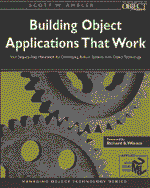 Building Object Applications that Work
Building Object Applications that Work Book contents
- Frontmatter
- Contents
- About the Author
- Foreword
- Preface
- Acknowledgments
- Part I INTRODUCTION TO BUILDING OBJECT APPLICATIONS
- Part II OBJECT-ORIENTED ANALYSIS, DESIGN, AND ARCHITECTURE
- Chapter 2 Bubbles and Lines—Useful Diagrams for Object-Oriented Analysis and Design
- Chapter 3 Improving Your Design—A Class-Type Architecture
- Chapter 4 Reusing Your Development Efforts—Object-Oriented Patterns
- Chapter 5 Development in the 90s and Beyond—Designing Distributed Object-Oriented Applications
- Part III OBJECT-ORIENTED CONSTRUCTION
- Part IV OBJECT-ORIENTED TESTING
- Part V CONCLUSION
- APPENDICES
- Index
Chapter 2 - Bubbles and Lines—Useful Diagrams for Object-Oriented Analysis and Design
from Part II - OBJECT-ORIENTED ANALYSIS, DESIGN, AND ARCHITECTURE
Published online by Cambridge University Press: 07 September 2010
- Frontmatter
- Contents
- About the Author
- Foreword
- Preface
- Acknowledgments
- Part I INTRODUCTION TO BUILDING OBJECT APPLICATIONS
- Part II OBJECT-ORIENTED ANALYSIS, DESIGN, AND ARCHITECTURE
- Chapter 2 Bubbles and Lines—Useful Diagrams for Object-Oriented Analysis and Design
- Chapter 3 Improving Your Design—A Class-Type Architecture
- Chapter 4 Reusing Your Development Efforts—Object-Oriented Patterns
- Chapter 5 Development in the 90s and Beyond—Designing Distributed Object-Oriented Applications
- Part III OBJECT-ORIENTED CONSTRUCTION
- Part IV OBJECT-ORIENTED TESTING
- Part V CONCLUSION
- APPENDICES
- Index
Summary
What We'll Learn in This Chapter
Why we need each type of diagram.
How to draw each type of diagram.
How to read class diagrams drawn in other modeling notations.
How and when to use use-case diagrams, sequence diagrams, state diagrams, process models, data models, collaboration diagrams, and interface-flow diagrams.
This book is an extension of The Object Primer and in this chapter we'll extend our knowledge of object-oriented analysis-and-design techniques. This chapter is perfect for people who wish to gain a broad understanding of the analysis-and-design options that are open to them when developing a system.
There's more to object-oriented (OO) development than CRC (Class Responsibility Collaborator) models, use cases, and class diagrams. Although all three techniques are useful, they don't give you the whole picture. In this chapter we'll see several types of diagrams that help to fill in the blanks: use-case diagrams, sequence diagrams, state diagrams, interface-flow diagrams, data models, collaboration diagrams, and process diagrams. We're also going to compare the Ambler notation with other leading notations to help you understand the class diagrams that you see in other OO development books.
The Importance of Bubbles and Lines
Management is constantly talking about deliverables. These are usually, but not always, physical by-products of your development effort. Although the ultimate deliverable should be a fully functioning application that has been successfully installed and accepted by the user, interim deliverables often include project plans, analysis documents, design documents, test plans, and so on.
- Type
- Chapter
- Information
- Building Object Applications that WorkYour Step-by-Step Handbook for Developing Robust Systems with Object Technology, pp. 49 - 84Publisher: Cambridge University PressPrint publication year: 1997
